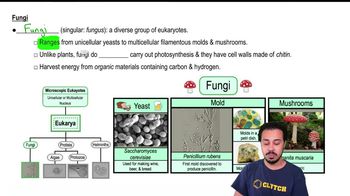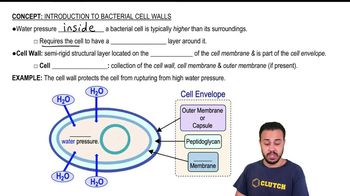Use the following choices to answer questions 9 and 10.
1. 9 + 2 flagella
2. 70s ribosome
3. fimbria
4. nucleus
5. peptidoglycan
6. plasma membrane
Which is (are) found only in prokaryotes?
a. 1,4,6
b. 3,5
c. 1,2
d. 4
e. 2,4,5
 Verified step by step guidance
Verified step by step guidance



Use the following choices to answer questions 9 and 10.
1. 9 + 2 flagella
2. 70s ribosome
3. fimbria
4. nucleus
5. peptidoglycan
6. plasma membrane
Which is (are) found only in prokaryotes?
a. 1,4,6
b. 3,5
c. 1,2
d. 4
e. 2,4,5
Bergey’s Manual of Systematics of Archaea and Bacteria differs from Bergey’s Manual of Determinative Bacteriology in that the former
a. groups bacteria into species.
b. groups bacteria according to phylogenetic relationships.
c. groups bacteria according to pathogenic properties.
d. groups bacteria into 19 species.
e. all of the above
Bacillus and Lactobacillus are not in the same order. This indicates that which one of the following is not sufficient to assign an organism to a taxon?
a. biochemical characteristics
b. amino acid sequencing
c. phage typing
d. serology
e. morphological characteristics
DRAW IT Use the following rRNA information to construct a cladogram for some of the organisms used in question 4. What is the purpose of a cladogram? How does your cladogram differ from a dichotomous key for these organisms?
<IMAGE>
Which of the following is false about scientific nomenclature?
a. Each name is specific.
b. Names vary with geographical location.
c. The names are standardized.
d. Each name consists of a genus and specific epithet.
e. It was first designed by Linnaeus.
DRAW IT Use the information in the following table to complete the dichotomous key to these organisms. What is the purpose of a dichotomous key? Look up each genus in Chapter 11, and provide an example of why this organism is of interest to humans.
<IMAGE>